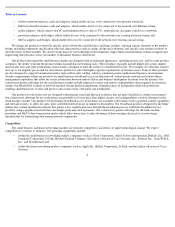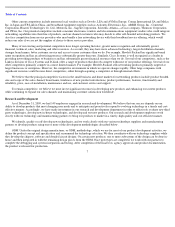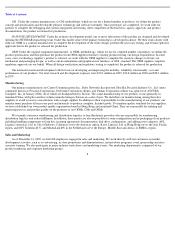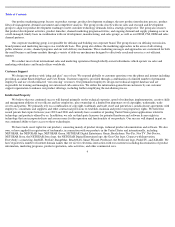Netgear 2009 Annual Report Download - page 18
Download and view the complete annual report
Please find page 18 of the 2009 Netgear annual report below. You can navigate through the pages in the report by either clicking on the pages listed below, or by using the keyword search tool below to find specific information within the annual report.
Table of Contents
We are required to evaluate our internal controls under Section 404 of the Sarbanes-Oxley Act of 2002 and any adverse results from
such evaluation could impact investor confidence in the reliability of our internal controls over financial reporting.
Pursuant to Section 404 of the Sarbanes-Oxley Act of 2002, we are required to furnish a report by our management on our internal control
over financial reporting. Such report must contain among other matters, an assessment of the effectiveness of our internal control over financial
reporting as of the end of our fiscal year, including a statement as to whether or not our internal control over financial reporting is effective. This
assessment must include disclosure of any material weaknesses in our internal control over financial reporting identified by management.
During the second quarter of fiscal 2009, in connection with the restatement of our previously issued financial statements for the period
ended March 29, 2009, and our assessment of our disclosure controls and procedures, management concluded that as of March 29, 2009, our
disclosure controls and procedures were not effective and that we had a material weakness in internal control over financial reporting. The
material weakness related to the accounting for income taxes. Specifically, we did not maintain a sufficient complement of tax personnel with
the required proficiency to identify, evaluate, review, and report complex tax accounting matters. In order to remediate the material weakness,
we hired additional personnel in the tax department with sufficient knowledge and experience in tax to strengthen the controls around the tax
provision. We also engaged tax specialists to assist us in the preparation and review of the income tax provision. As a result of these actions,
management has concluded that we have remediated the material weakness related to income taxes as of December 31, 2009.
We will continue to perform the system and process documentation and evaluation needed to comply with Section 404, which is both
costly and challenging. During this process, if our management identifies one or more material weaknesses in our internal control over financial
reporting, we will be unable to assert such internal control is effective. If we are unable to assert that our internal control over financial reporting
is effective as of the end of a fiscal year or if our independent registered public accounting firm is unable to express an opinion on the
effectiveness of our internal control over financial reporting, we could lose investor confidence in the accuracy and completeness of our financial
reports, which may have an adverse effect on our stock price.
We are subject to numerous governmental regulations concerning the manufacturing and use of our products. We must stay in
compliance with all such regulations and any future regulations. Any failure to comply with such regulations, and the unanticipated
costs of complying with future regulations, may adversely affect our business, financial condition and results of operations.
We manufacture and sell products which contain electronic components, and as such components may contain materials that are subject to
government regulation in both the locations that we manufacture and assemble our products, as well as the locations where we sell our products.
An example of a regulated material is the use of lead in electronic components. We maintain compliance with all current government regulations
concerning the materials utilized in our products, for all the locations in which we operate. Since we operate on a global basis, this is a complex
process which requires continual monitoring of regulations and an ongoing compliance process to ensure that we and our suppliers are in
compliance with all existing regulations. There are areas where future regulations may be enacted which could increase our cost of the
components that we utilize. While we do not currently know of any proposed regulation regarding components in our products, which would
have a material impact on our business, if there is an unanticipated new regulation which significantly impacts our use of various components or
requires more expensive components, that would have a material adverse impact on our business, financial condition and results of operations.
Our manufacturing process is also subject to numerous governmental regulations, which cover both the use of various materials as well as
environmental concerns. We maintain compliance with all current government regulations concerning our production processes, for all locations
in which we operate. Since we operate on a global basis, this is also a complex process which requires continual monitoring of regulations and
an ongoing
16
























